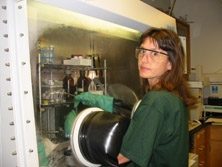
School:
Grade Level:
Teaching Position:
Department:
Mentor:
Research Project Year:
Research Project Title:
Research Project Description:
Scientists in the Deming research group synthesize polypeptides having a wide range of material applications (fibers, membranes, and coatings) and potential biomedical uses, such as tissue engineering and drug delivery. To develop polypeptides with predetermined properties, polymerization must be carefully controlled to ensure that the resulting polymer is pure and of a desired molecular weight. Controlled polymerization is activated by an?initiator? molecule which reacts with a monomer unit to begin the reaction. The reaction between the initiator and monomer creates an?activated center? which is passed to each successive monomer joining the chain during polymerization. Researchers in the Polymer Characterization Lab identify initiators which are effective in activating polymerization, and then characterize the polypeptides produced.
The purpose of my research was to test the effectiveness of three initiator molecules in polymerizing a monomer called Glu-NCA. Under Dr. Brzezinska?s guidance, I prepared the series of reactions by mixing Glu-NCA, initiator, and solvent together in a?drybox? - an enclosed nitrogenous chamber which is oxygen and water-free. The resulting polypeptides were analyzed using a GPC (Gel Permeation Chromotography) light scattering detector, which calculates the average number of molecules in the polymer and how they are distributed. My results showed that the initiators were effective in activating polymerization in Glu-NCA. Next step: to find out if the initiators we used are ?difunctional? ? can polymerize in two directions at once!
Research Project Attachments:
| Attachment | Size |
|---|---|
| 756.59 KB |
Curriculum Project Year:
Curriculum Project Title:
Curriculum Project Description:
Classroom management and monitoring strategies are essential for creating a productive learning environment and maximizing student achievement. A quiet, orderly, and efficient working environment increases on-task time and improves motivation, concept mastery, and performance. General classroom routines and rules should be the first skills implemented in every classroom. In addition, procedures for group work must be established BEFORE students begin interactive activities. This project focuses on procedures, routines, and rules/consequences important to an efficiently run classroom. Typical life science activities are presented along with suggested procedures, grouping management tips, and monitoring techniques important for effective learning.
The activities presented in this project focus on 7th grade level; however, the management techniques may be used at any grade level. Most activities take between 1-3 days. (All are part of larger units, however.) The science content standards covered include Cell Biology (1a, 1b, 1c, 1d, 1e); Genetics (2, 2b, 2c, 2d, 2e); Earth and Life History (4, 4c, 4d, 4f); Investigation (7, 7a, 7b, 7c, 7d, 7e).
Curriculum Project Attachments:
| Attachment | Size |
|---|---|
| 1.55 MB |
